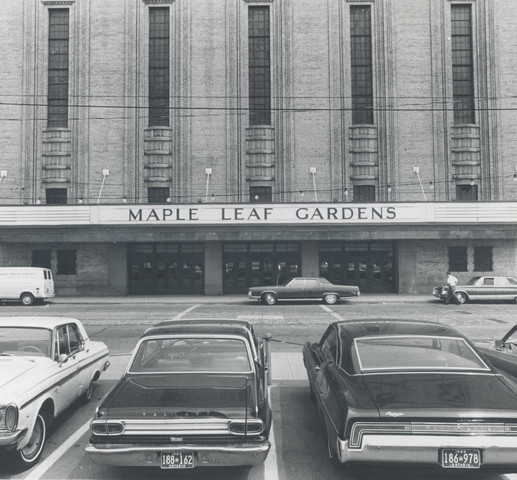
The Heart of Music City: Maple Leaf Gardens
Maple Leaf Gardens
Exterior of Maple Leaf Gardens on Carlton Street, 1969. Photograph by Bob Olsen, courtesy of Toronto Star Photo Archives.
Liberal rally, Maple Leaf Gardens, October 1935. Photo by William James. City of Toronto Archives, Fonds 1244, Item 643A.
Bill Haley and the Comets, Maple Leaf Gardens, 1956. City of Toronto Archives, Fonds 1257, Series 1057, Item 7214.
The Isley Brothers, Maple Leaf Gardens, 1960. City of Toronto Archives, Fonds 1257, Series 1057, Item 7251
More than a hockey arena
Although Maple Leaf Gardens was built as a hockey arena, throughout its history, it has hosted a wide variety of events, from wrestling to opera. As early as 1932, the Gardens hosted internationally renowned speakers, such as Winston Churchill.
The beginning of the Gardens’ long history with music was in October 1935, with an epic musical extravaganza featuring the Radio City Ballet and Proms Orchestra, who entertained a crowd of 9,000: at that time, the second-largest indoor music crowd ever assembled in Toronto. The grand finale featured 60 ballet dancers performing to Maurice Ravel’s “Bolero” on the Gardens’ main floor, a spectacle that earned the dancers and orchestra three encores.
Making rock history
Two defining moments in early Toronto rock history occurred at Maple Leaf Gardens, one in 1956 and the other in 1957.
The “Biggest Show of ‘56” featured rock icons such as Chuck Berry as well as Bill Haley and His Comets singing “Shake Rattle and Roll,” the first rock and roll song to become an international hit. The fans that descended on the Gardens for the performance confirmed rock was here to stay in Toronto.
Toronto’s love of rock and roll convinced Elvis Presley to perform at the Gardens in 1957, one of only three times he ever held a public concert outside the United States.
Beatlemania comes to town
Maple Leaf Gardens hosted three Beatles concerts in three years: 1964, 1965, and 1966. On tour to promote their latest album and film, “A Hard Day’s Night”, Toronto welcomed the Beatles with open arms. However, the Gardens’ infamously terrible sound system meant the band could barely be heard.
The arena sound system—the same used to make announcements during hockey games—was used to amplify the band. Combined with 15,000 screaming Beatles fans filling the stands, anything John, Paul, George, and Ringo may have been playing on stage was impossible to hear.
The shifting music landscape
Maple Leaf Gardens hosted the best in the music business for over fifty years. Many Toronto bands, such as Rush and the Band, returned to the city specifically to play the Gardens, considering it a benchmark of success.
In 1999, the Air Canada Centre opened in downtown Toronto. With a capacity of over 19,000, the new venue effectively ended Maple Leaf Gardens’ fifty-year reign as the city’s only arena-level concert venue.

